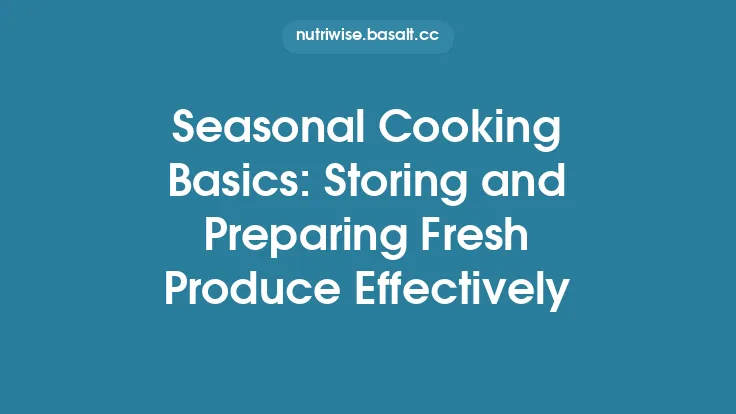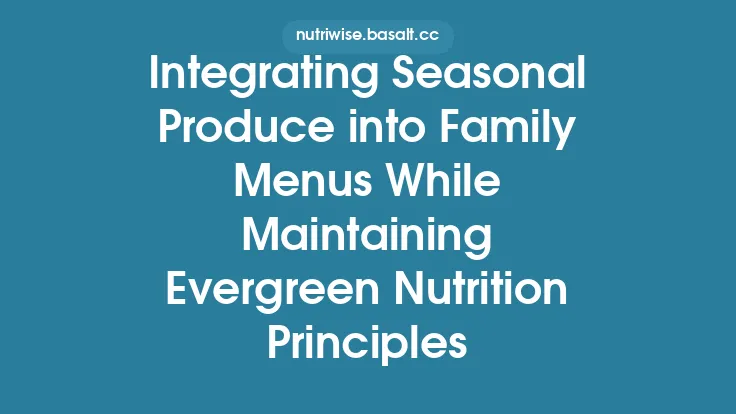The rhythm of the earth’s climate dictates what crops flourish at any given moment, and by aligning our kitchens with these natural cycles we can enjoy produce at its most flavorful, nutritious, and cost‑effective. Year‑round seasonal cooking isn’t about chasing a single “perfect” menu; it’s a systematic approach to selecting, preparing, and integrating the bounty of each season into everyday meals. Below is a comprehensive guide that walks you through the principles, decision‑making tools, and culinary techniques that empower you to cook with the freshest ingredients all year long.
Understanding Seasonal Cycles
Climatic Drivers
- Temperature thresholds: Most fruit and vegetable species have defined minimum and maximum temperature ranges for optimal growth. For example, cool‑season crops such as kale and carrots thrive when average daytime highs stay between 50–70 °F, while warm‑season vegetables like tomatoes and peppers require sustained temperatures above 70 °F.
- Photoperiod: Day length influences flowering and fruit set. Short‑day plants (e.g., spinach) initiate leaf growth earlier in the spring, whereas long‑day plants (e.g., beans) peak later in summer.
- Rainfall patterns: Soil moisture availability determines whether a crop will be “dry‑season” (e.g., sweet potatoes) or “wet‑season” (e.g., rice). Understanding regional precipitation helps predict when certain produce will be at its peak.
Phenology and Harvest Windows
Phenology—the study of periodic plant life cycle events—provides a scientific framework for mapping harvest windows. By consulting phenological charts for your region (often available through university extension services), you can pinpoint:
- Bud break – the first sign of growth.
- Flowering – a key indicator of upcoming fruit set.
- Maturity – the optimal point for flavor and nutrient density.
These stages differ not only by species but also by cultivar, so a “late‑season” heirloom tomato may reach peak flavor weeks after a standard hybrid.
Identifying Peak Produce in Each Season
Below is a concise, evergreen reference for the most common produce groups, organized by the four temperate seasons. The list emphasizes items that reach their highest quality when harvested locally.
| Season | Leafy Greens & Herbs | Root & Tuber Vegetables | Fruit & Pods | Cruciferous & Brassicas |
|---|---|---|---|---|
| Spring | Arugula, baby spinach, chives, parsley | New potatoes, radishes, carrots (young) | Strawberries, rhubarb, peas | Broccoli, cauliflower, bok choy |
| Summer | Basil, cilantro, mint, kale (mature) | Sweet potatoes, beets, turnips | Tomatoes, zucchini, bell peppers, berries | Brussels sprouts (late summer), cabbage |
| Autumn | Swiss chard, mustard greens, sage | Parsnips, rutabaga, carrots (mature) | Apples, pears, grapes, figs | Kale, collard greens, cabbage |
| Winter | Kale, collards, winter lettuce, rosemary | Sunchokes, turnips, carrots (late) | Citrus (oranges, grapefruits), pomegranates | Brussels sprouts, cauliflower, kale |
*Tip:* When a produce item appears in multiple seasons, its flavor profile often shifts—e.g., early‑summer tomatoes are bright and acidic, while late‑autumn varieties become sweeter and richer. Adjust seasoning and cooking methods accordingly.
Evaluating Quality and Freshness
Visual Cues
- Color intensity: Deep, uniform coloration usually signals full ripeness. Pale or uneven hues can indicate under‑development or post‑harvest degradation.
- Texture: Firmness without brittleness is ideal for most vegetables. For leafy greens, crisp, non‑wilting leaves are preferred.
- Surface integrity: Look for minimal bruising, cracks, or mold. Small blemishes are often cosmetic and do not affect flavor.
Olfactory Indicators
- Aromatic freshness: Herbs should emit a strong, herbaceous scent; wilted or stale aromas suggest age.
- Sweetness in fruit: A subtle, natural fragrance often correlates with higher sugar content.
Tactile Assessment
- Weight-to-size ratio: Heavier produce for its size typically contains more water and nutrients (e.g., a dense, heavy watermelon versus a light one of similar dimensions).
Laboratory Metrics (Optional)
For those seeking a data‑driven approach, portable refractometers can measure soluble solids (°Brix) in fruit, providing a quantitative gauge of sweetness. Similarly, handheld spectrometers can assess chlorophyll content in greens, indicating freshness.
Sourcing Strategies: Farmers’ Markets, CSAs, and Wholesale
Direct‑to‑Consumer Channels
- Farmers’ markets: Offer the most immediate connection to growers, allowing you to ask about harvest dates, varieties, and cultivation practices. Seasonal “micro‑harvests” often appear here before they reach grocery aisles.
- Community Supported Agriculture (CSA): Subscribing to a CSA provides a curated selection of in‑season produce on a weekly or bi‑weekly basis. This model encourages you to experiment with unfamiliar items and reduces food miles.
Wholesale and Co‑ops
- Regional co‑ops: These aggregate produce from multiple farms, giving you access to a broader range of items while still maintaining seasonality.
- Specialty distributors: For chefs or serious home cooks, partnering with a distributor that emphasizes “peak‑season” sourcing can guarantee consistent quality, albeit at a higher price point.
Ethical and Sustainability Considerations
- Organic vs. conventional: While organic certification ensures no synthetic pesticides, it does not guarantee superior flavor. Prioritize farms that practice integrated pest management (IPM) and soil health regeneration.
- Local vs. imported: Even when a product is technically “in season” elsewhere, importing it can diminish its nutritional value and increase carbon footprint. Favor locally grown items whenever possible.
Sustainable and Ethical Considerations
Soil Health and Regenerative Practices
- Cover cropping: Crops like clover and rye protect soil, improve moisture retention, and enhance nutrient cycling, resulting in healthier produce.
- No‑till farming: Reduces soil erosion and preserves microbial communities that contribute to plant vigor.
Water Stewardship
- Drip irrigation: Delivers water directly to the root zone, minimizing waste.
- Rainwater harvesting: Some farms use collected rainwater for irrigation, reducing reliance on municipal supplies.
Biodiversity
- Heirloom varieties: Maintaining genetic diversity safeguards against disease and climate variability. Heirloom produce often offers unique flavors and textures not found in commercial hybrids.
- Polyculture: Growing multiple species together can deter pests naturally and improve overall ecosystem resilience.
When selecting produce, ask vendors about these practices. Supporting farms that prioritize sustainability contributes to a more resilient food system and often yields superior flavor.
Techniques for Extending Seasonal Produce
While the goal is to eat produce at its peak, there are times when you’ll want to preserve excess harvests for later use. Below are advanced methods that maintain nutritional integrity and culinary versatility.
Freezing
- Blanching: Briefly submerge vegetables (e.g., green beans, broccoli) in boiling water (1–3 minutes) then shock in ice water. This halts enzymatic activity, preserving color, texture, and vitamin C.
- Flash‑freeze: Spread items on a tray to freeze individually before bagging, preventing clumping.
Drying and Dehydration
- Low‑temperature oven or food dehydrator: Set to 125–135 °F for fruits and herbs. Drying concentrates sugars, making dried apples or apricots natural sweeteners.
- Air‑drying: Suitable for herbs and certain leafy greens; tie stems together and hang in a well‑ventilated, low‑humidity space.
Fermentation
- Lacto‑fermentation: Submerge vegetables (cabbage, carrots, radishes) in a brine solution (2–3 % salt) and allow natural lactic acid bacteria to develop. This not only extends shelf life but also enhances probiotic content.
- Kimchi‑style preparations: Combine a variety of seasonal vegetables with garlic, ginger, and chili for a complex, nutrient‑dense condiment.
Canning (Water‑Bath and Pressure)
- Acidic produce (tomatoes, fruits) can be safely processed in a boiling water bath.
- Low‑acid vegetables (beans, carrots) require pressure canning to reach 240 °F, eliminating botulism risk.
Pickling
- Quick pickles: Soak sliced vegetables in a vinegar‑based brine (5 % acidity) for 24–48 hours. This method preserves crispness and adds a tangy dimension to salads and sandwiches.
Each preservation technique has its own impact on texture, flavor, and nutrient retention. For instance, freezing retains most vitamins but can cause cell wall rupture, leading to a softer texture upon thawing—ideal for soups and stews but less so for fresh salads.
Integrating Seasonal Produce into Meal Planning
Core Principles
- Anchor meals around a seasonal star: Choose one primary vegetable or fruit as the focal point, then build complementary components around it.
- Balance cooking methods: Pair raw or lightly cooked items (e.g., spring peas) with more robust preparations (e.g., roasted carrots) to create textural contrast.
- Leverage pantry staples: Grains, legumes, and nuts provide a neutral canvas that lets seasonal flavors shine without competing.
Sample Weekly Framework
| Day | Seasonal Star | Complementary Elements | Suggested Cooking Technique |
|---|---|---|---|
| Monday | Early‑summer zucchini | Quinoa, feta, mint | Grilled, then tossed cold |
| Tuesday | Autumn apples | Pork tenderloin, sage, roasted potatoes | Pan‑sear pork, finish with apple compote |
| Wednesday | Winter kale | White beans, smoked paprika, brown rice | Braised in broth |
| Thursday | Spring radishes | Avocado, lime, cilantro | Thinly sliced raw in salad |
| Friday | Late‑summer tomatoes | Burrata, basil, toasted baguette | Roasted halves, served warm |
By rotating the “seasonal star” each day, you maintain variety while staying anchored to what’s freshest.
Cooking Methods Tailored to Seasonal Textures
Spring – Delicate and Tender
- Steaming: Preserves the subtle sweetness of young peas and asparagus without overcooking.
- Quick sauté: Lightly coat baby greens in olive oil for 30–45 seconds; this retains crispness and bright color.
Summer – Firm and Juicy
- Grilling (direct heat): Char marks on corn, eggplant, and bell peppers develop Maillard flavors while keeping interiors moist.
- Raw preparations: Summer berries and stone fruits excel in salads and salsas where their natural juices can be showcased.
Autumn – Dense and Earthy
- Roasting: Slow, dry heat caramelizes sugars in root vegetables (e.g., carrots, parsnips), deepening flavor.
- Braising: Tougher greens like kale benefit from a brief simmer in broth, softening fibers while preserving nutrients.
Winter – Sturdy and Robust
- Slow‑cooking: Low‑and‑slow methods (e.g., crockpot) break down fibrous winter squash and turnip skins, yielding silky textures.
- Pickling & Fermentation: Winter’s abundant cabbage and radicchio become excellent candidates for preservation, adding tang and probiotic benefits to meals.
Nutritional Benefits of Seasonal Eating
While the article avoids macro‑balancing specifics, it’s worth noting that seasonal produce often contains higher concentrations of phytonutrients due to optimal growing conditions.
- Antioxidant peaks: Studies show that tomatoes harvested at full ripeness (late summer) have up to 30 % more lycopene than early‑season varieties.
- Vitamin density: Spring greens, grown during a period of rapid leaf expansion, accumulate higher levels of vitamin K and folate.
- Mineral availability: Soil temperature influences mineral uptake; for instance, winter carrots can have elevated potassium levels due to prolonged root development.
Consuming a rotating spectrum of seasonal foods naturally diversifies your micronutrient intake, reducing the risk of deficiencies without the need for meticulous macro calculations.
Adapting Recipes to Seasonal Variations
Substitution Framework
When a recipe calls for a specific ingredient that is out of season, replace it with a close relative that shares similar moisture, texture, and flavor profile.
| Original (Out‑of‑Season) | Seasonal Substitute | Reasoning |
|---|---|---|
| Bell pepper (summer) | Sweet summer squash | Comparable crunch and mild sweetness |
| Strawberries (winter) | Pomegranate arils | Same bright acidity and burst of juice |
| Basil (winter) | Fresh parsley + a dash of lemon zest | Maintains herbaceous freshness |
| Asparagus (fall) | Broccolini | Similar spear shape and quick cooking time |
Flavor Development Adjustments
- Acidity: Summer produce often benefits from a splash of citrus to balance natural sugars; autumn vegetables may need a touch of vinegar or mustard to cut richness.
- Sweetness: In cooler months, adding a small amount of natural sweetener (e.g., maple syrup) can compensate for the milder flavor of winter greens.
By understanding the underlying sensory attributes of each ingredient, you can confidently modify recipes while preserving their intended character.
Overcoming Common Challenges
Limited Availability in Urban Areas
- Community gardens: Many cities host plots where residents can grow their own seasonal crops.
- Online farm-to-door services: Some farms ship boxes of in‑season produce directly to consumers, expanding access beyond local markets.
Price Fluctuations
- Bulk purchase during peak: Buy larger quantities of a seasonal staple (e.g., carrots) when prices dip, then preserve excess using freezing or pickling.
- Cross‑seasonal storage: Root cellars can keep hardy vegetables (potatoes, onions) at optimal temperature (45–55 °F) and humidity (85–90 %) for months, smoothing out price spikes.
Quality Variability
- Multiple vendor sampling: Purchase small amounts from several sources to compare freshness and flavor.
- Seasonal “test runs”: Before committing to a large batch, try a quick recipe with a small portion to gauge quality.
Building a Personal Seasonal Produce Calendar
- Map your region’s climate zones: Identify USDA hardiness zones or equivalent local classifications.
- Create a month‑by‑month matrix: List primary produce groups for each month, noting any “early” or “late” windows.
- Highlight local festivals and farmers’ market dates: These often coincide with peak harvests of specific crops.
- Set quarterly review points: At the start of each season, assess what’s abundant, what needs preservation, and what gaps exist in your pantry.
- Integrate with grocery planning apps: Many apps allow you to tag items as “seasonal,” generating alerts when they become available locally.
A living calendar not only streamlines shopping but also encourages experimentation, as you’ll be reminded to try new varieties each season.
Conclusion
Year‑round seasonal cooking is a dynamic, evidence‑based practice that aligns culinary choices with nature’s own timetable. By mastering the science of phenology, honing the art of quality assessment, sourcing responsibly, and employing preservation techniques that respect nutrient integrity, you can enjoy the freshest, most flavorful produce every day of the year. The result is a kitchen that celebrates diversity, supports sustainable agriculture, and delivers meals that are nutritionally robust and endlessly inspiring. Embrace the seasonal rhythm, and let each harvest become the foundation for your next culinary adventure.





